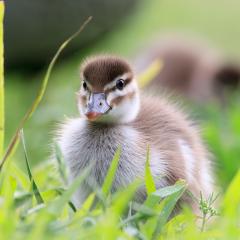
Who doesn’t love ducks?! From cute, furry ducklings waddling around the lakes to majestic matrons shepherding their flocks across the Great Court, UQ’s feathery friends turn up almost everywhere on the St Lucia campus. They even star in their own social media account!
This month, we introduce you to a couple of our most common species and share some tips for getting along.
Who’s who in the zoo
The predominant species at the St Lucia campus are the Australian wood duck and the Pacific black duck.
If you’ve been down to the revitalised lakes precinct this year, these are the 2 types you are most likely to have seen.
Although they may look similar on first glance, each has a few characteristics that should help you to tell them apart, says UQ grounds manager, Shane Biddle.
For one thing, Australian wood ducks are rarely spotted out on open water. They like to live on land and primarily forage for food in the shallows or in grass, crops or wetlands. They are slightly smaller (45cm-50cm) and are mostly grey with a brown head and speckled breast.
The Pacific black duck, on the other hand, is a bit bigger at 50cm-60cm and much more commonly found in the water. It forages in the ‘traditional’ duck manner of dabbling down with its bottom in the air. It is browny-coloured but has a distinctive, metallic teal patch among its feathers.
Although several other species have been spotted on campus in recent years, most non-native ducks were relocated away from the University during the lakes project. This was undertaken as part of UQ’s Biodiversity Management Program, which aims to conserve natural ecosystems while offering safe natural habitats for native species.
Find out more about both our main duck species on the Australian Museum website: Australian wood duck, Pacific black duck.
Always observe the ducks from a distance. Please remember they are wild animals in their native habitat, and we need to respect their space for both our own – and their – comfort and safety.
Better off without bread
Ducks might look like they love your leftover bread, but it really isn’t good for them, say UQ’s grounds and biodiversity team.
The Australian wood duck’s diet primarily comprises grasses, clover, other herbs and occasionally insects. The Pacific black duck sticks to a similarly plant-based regime but may also eat small seafood organisms and other aquatic insects.
If you feed the ducks your food picnic instead, it can cause them to become dependent on you for nutrition.
This is when they tend to develop aggressive behaviours, as they lose their ability to forage. See our tips for wildlife management at UQ.
Don’t pat the ducklings
The other important thing to be aware of is ducks’ breeding behaviours and patterns, Mr Biddle says.
Although spring and summer are often thought of as peak breeding seasons, ducklings have been spotted on campus pretty much year-round, especially during periods of warmer-than-usual weather.
Both the Australian wood and the Pacific black duck like to nest in tree holes or sometimes old nests of other birds. They have even been known to nest in our old possum boxes on campus, if they’ve been abandoned, Mr Biddle says.
The Australian wood duck will typically lay between eight and 10 eggs, which incubate for roughly a month. Their chicks will then stay in the nest for just under two months.
“The number one tip is just to give the ducks their space. This always applies, but especially when they are nesting,” he explains.
“Don’t pat or try to pick up the ducklings. Just don’t interact with them at all.
“And be aware if you do see a group of chicks, the mother will likely be close by. We don’t want to separate them, as the babies are entirely dependent on their mother in their early days.”
Why did the duck cross the road …?
Yes, our little ducklings do try to cross the road from time to time.
“Don’t forget that when they’re born, they can’t fly,” Mr Biddle reminds us.
“So, they have to walk everywhere. We will sometimes come across the mums trying to shepherd their little flocks across Sir Fred Schonell Drive.
“In those cases, when it is safe to do say, the grounds team will carefully help the ducks to cross the road.
“But we’ve rescued ducklings from all sorts of places over the years.
“We have built ramps out of fountains, coaxed them out of stormwater drains, and even scooped them up from inside the occasional classroom,” Mr Biddle says.
DON’T FORGET: If you do see any ducklings stranded or otherwise in need of assistance on campus, it might be tempting to try to help them yourself, but please stop and call the appropriate person. You can find a list of contacts and a process here for assistance.
Image credits: David de Groot



